There has been a lot of talk about conventional digital cameras coming under threat from improving hybrids, like camera phones, PDAs with cameras and camcorders with still photo capability. Indeed, I'm of the firm opinion that some time in the future, perhaps as close as 2-3 years, most new consumer digital cameras will be dual-function still and video cameras that will produce prints up to A4 size at a quality we'd be satisfied with, plus camcorder quality video.
I even think that high quality premium cameras of the future will record continuous motion, allowing selective frame extraction for high quality still reproduction. But that's quite a way off yet. What about today? I decided to take four different types of affordable digital camera and take a selection of pictures under the same conditions and then print them on 6x4 inch media.
All the image quality evaluation was decided on the prints alone, made using a Canon Pixma iP6000D ink jet photo printer on 6x4 inch premium quality glossy photo media (Canon Photo Paper Pro).
The cameras used in this experiment included a Mustek GSmart D35 budget digital camera, representing the still camera market sector that is most under pressure from camera phones, a Nokia 7710 one megapixel camera phone, a Sony DCR-PC105e one megapixel camcorder with still photo mode and, finally, a Panasonic Lumix DMC-LZ1 four megapixel affordable conventional digital still camera.
Were there any surprises? Read on to see how the contestants fared.
Mustek GSmart D35 budget digital camera
Typical selling price (approx): UK£50, US$90, EU€75

How many megapixels?
3.5 megapixels is emblazoned across the top of this diminutive camera and, indeed, in best quality mode the image file resolution is 2144x1608 pixels, or 3.44 million effective pixels. But the truth is that under its microscopically small lens, which isn't endowed with autofocus or optical zooming, lies a CMOS sensor chip with an actual resolution of only 2.0 megapixels. Shutter lag is very noticeable.
On the side of the camera is a switch that toggles between close focus and infinity focus mode. A sliding front cover protects the lens and large flash unit but doesn't, as you might expect, double as the power on/off switch. That's on the top side of the camera and there is a fair wait for the camera to wake up and be ready for shooting.
16MB of built in memory means you don't need a memory card for occasional use, though an SD/MMC card slot is provided. The camera can be connected via USB cable to a PC, via which both image files and movie clips can be downloaded. You can also use the camera as a simple webcam. Just two AAA batteries power the camera.
A 1.5 inch colour LCD screen is provided for viewing the simple configuration menus and pictures you have taken. The menu legends are quite primitive and sometimes difficult to decipher and photos are displayed in somewhat murky colours.
Picture quality
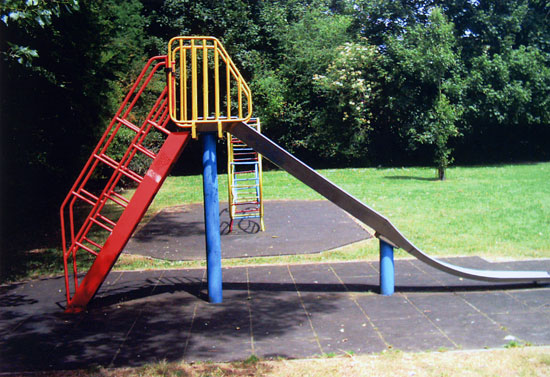
The print of the playground slide illustrated a lot of basic quality problems with the Mustek D35. First of all there is no dark shadow detail and yet the grass is quite light. This is a classic example of poor dynamic range. At least the colours aren't over-saturated – if anything, they are a little on the pale side. The green foliage is also a touch too blue. Sharpness is also poor.

In the softer light of the woods, the Mustek D35 produced a more pleasing result. There is still an overall softness to the picture, but this time the foliage colour is about right and the girls' skin tones are fine. The pink tee-shirt has become too red, however and some graininess is evident.
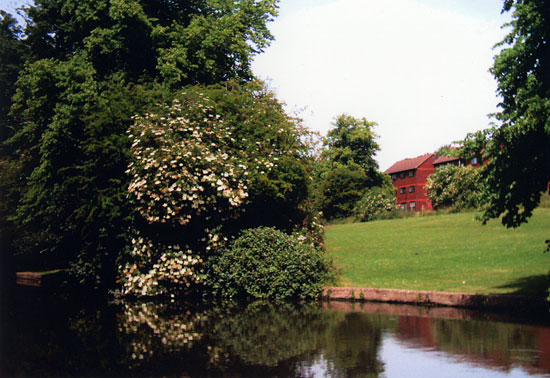
The view across the canal confirms the poor shadow detail, though suppression of purple fringing is quite good and the green of the grass is not too bad. The brickwork of the building, however, is too red. Again, the image is too soft.
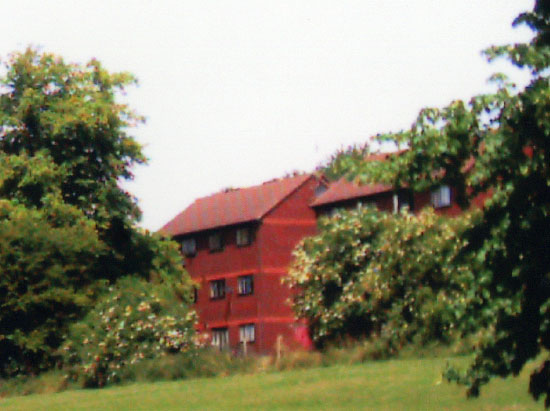
This selective enlargement of the canal view print really shows the kind of impression the print in the hand gives; being soft and too red in places. Moiré patterning is all over the roof of the building.
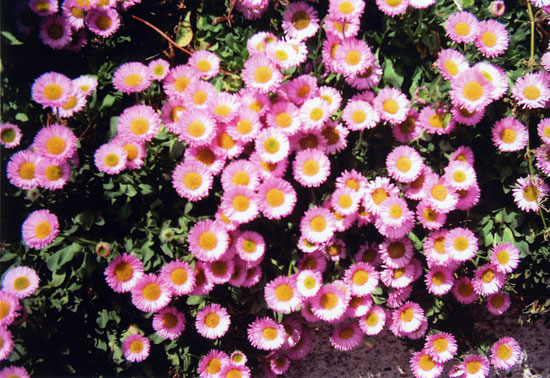
Taken with the close focus mode switched on, these flowers look attractive enough, but there is quite a bit of bleaching of highlights and in reality the flowers are a delicate shade of purpley pink, not reddish-pink. Again, sharpness is distinctly lacking.
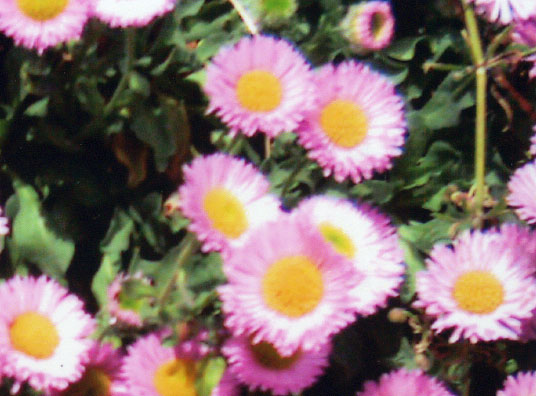
Zooming in on the top right of the print, the softness of the image is clear, though there is no sign of major sharpness fall-off in the corners. It's just like this right across the image!
Check the latest price or purchase options for the Mustek Gsmart D35 via

|

| 
|  |
| Click on the flag that best relates to your location |
| The EU flag links to Amazon Germany, currently the only European Amazon outlet that supplies electronic goods like cameras priced in Euros. |
| Each Amazon outlet can ship to most countries in the world. |
Nokia 7710 PDA/camera phone
Typical selling price (approx, without network contract): UK£300, US$500, EU€440

Recently discounted substantially, Nokia's distinctive 7710 triband phone with Bluetooth capability is also a PDA, with a surprisingly good web browser benefiting from an excellent 640x320 pixel 3.5 inch (diagonal) widescreen LCD. The camera is the now familiar one megapixel (1152x864 pixels) unit featured in a wide range of Nokia phones.

The camera lens is on the opposite side of to the large LCD screen and the only problem in use is that you need to press an on-screen 'capture' button to take a picture, which isn't ergonomically ideal. Shutter lag is very frustrating and it's not very easy to tell when the image has actually been recorded.
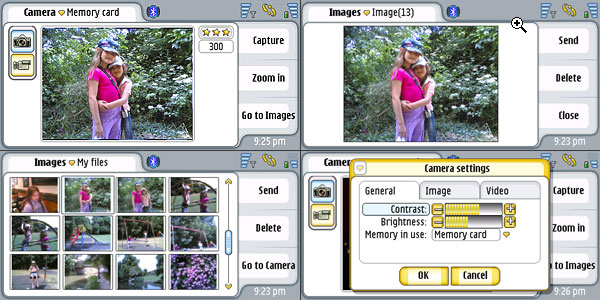
On-screen controls menus are generally easy to follow, though if you are used to a Palm or Pocket PC device, you will suffer from culture shock! As a PDA, the Nokia 7710 is comparatively under-powered, so you do end up waiting while it crunches its numbers. There is no WiFi facility and neither is the 7710 G3 compatible. Instead you are dependent on Bluetooth for a lot of external communications, though this works well and I had no problems printing to Bluetooth-enabled photo printers.
Only MMC cards are supported by the 7710, so you can't use SD cards (SD card slots are MMC compatible, but MMC slots aren't SD-compatible). On top of that you need to remove the back cover of the 7710 to access the card slot, which is quite difficult to do and you risk dropping the battery, too.
Picture quality

Considering the very limited specification of the Nokia 7710's one megapixel camera, the shadow detail in the playground slide scene above is actually superior to the two megapixel Mustek D35, though it's nowhere as good as the Panasonic Lumix DMC-LZ1. Alas, there isn't much more good news to tell as the colours are distinctly cool and there is precious little medium to fine detail. To make matters worse, there is detectable pixellation of straight edge detail and highlights are mostly bleached out.

Once again, the soft lighting of the woods flatters the Nokia 7710. The surrounding foliage is a bit under-saturated, but the tee-shirt colour and skin tones are not bad. The print looks sharp if you stand back but it does reveal a slight fuzziness on close inspection, but overall, quite a pleasing result.
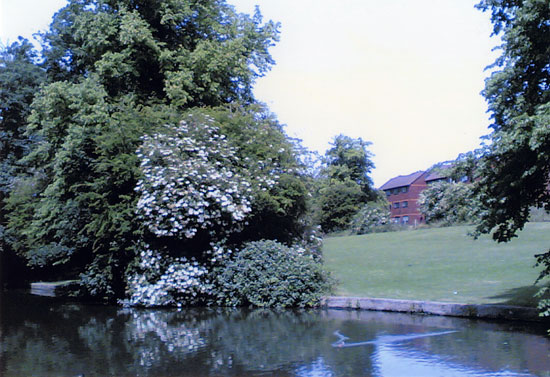
Across the canal, the scene really tests the Nokia 7710. Straight away the widespread blue-fringing of the tree periphery is very telling. Again, the picture is too blue, as if the white balance is wrong. There is also no detail in the grass; it's just a pastel green expanse.

The zoomed-in view just confirms things. It's very soft, lacking in saturation and the high contrast detail is smothered in a blue haze.

This shot of the flowers shows another oddity of the Nokia 7710's camera; blue shadows. The central area of the image is reasonably close to the true colour of the flowers, but it become progressively colder away from the centre. Sharpness is not too bad, better even than the higher resolution Mustek D35.
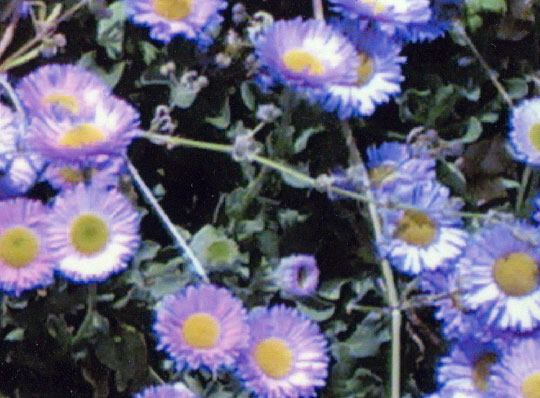
There is nothing wrong with the Nokia 7710's lens as this enlargement of the top right corner shows. The problems are concentrated in the lack of resolution and the colour processing of the image data.
Check the latest price or purchase options for the Nokia 7710 via

|

| 
|  |
| Click on the flag that best relates to your location |
| The EU flag links to Amazon Germany, currently the only European Amazon outlet that supplies electronic goods like cameras priced in Euros. |
| Each Amazon outlet can ship to most countries in the world. |
Sony DCR-PC105 Megapixel DV camcorder
Model featured no longer available. Comparable model prices (approx) UK£399, US$449, EU€549

This is my two year old Sony PC105e megapixel mini DV camcorder with still photo capability, including a small pop-up flash and memory stick card support. One thing camcorders have over budget still cameras, like the Mustek D35, and camera phones, is a nice big lens. There is plenty of glass in the PC105 and it has the attractive Carl-Zeiss label too. It's also an f/1.8 optic, necessary for low light videoing. As a camcorder, the PC105 has delivered everything that is expected of it and camcorder magazines rated its video quality.
Shutter lag in still mode is certainly a problem compared to contemporary still digital cameras. The angle of view is not very wide at its widest setting, but you do get the benefit of the 10x zooming range that equates to something like a 500mm telephoto at the extreme end of the range.
Picture quality

With the same number of pixels to play with as the Nokia 7710 camera phone, the Sony PC105 camcorder produces a generally more satisfying rendition of the playground slide scene. Colours are nicely saturated, there is shadow detail and yet the grass doesn't look bleached out. And you can see some detail in the turf. Much of this must be down to the big and bright lens. But where the Nokia 7710 holds its own is in colour bleed; the Sony PC105's red bars are leaking colour all over the place and there is more pixellation too.

The shady woods scene didn't do the Sony PC105 any favours. Image noise spoils some of the tonality of the print and there are areas that are out of focus, suggesting the picture was taken at full aperture. The Nokia 7710 produced a better print, if cooler in tone.
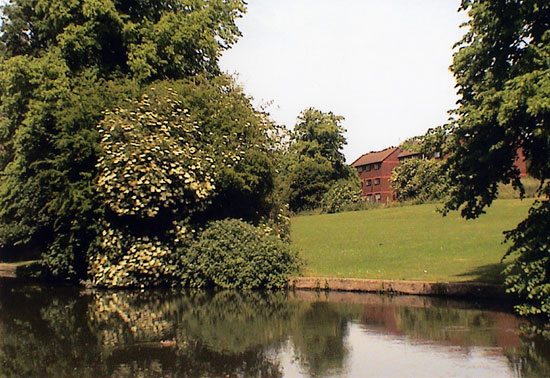
In the canal shot, there is too much warmth and the sky has become yellowish. The foliage isn't very sharp either, though there is more detail in the grass than in the Nokia 7710 version. Purple fringing is absent, though the boundary between the tree foliage and the sky is very abrupt and unnatural.

Zooming in on the house reveals some nasty artefacts around the high contrast boundaries, especially the roof line.

The Sony PC105 did the best job of all in faithfully reproducing the colour of the flowers, though the inconsistency of colour in other shots makes me wonder if this was just the result of sheer luck!

Corner sharpness of the flower picture is good, reinforcing the impression that the Sony PC105's big lens is a good performer.
******************************
Panasonic Lumix DMC-LZ1 conventional digital camera
Typical selling price (approx): UK£179, US$199, EU€249
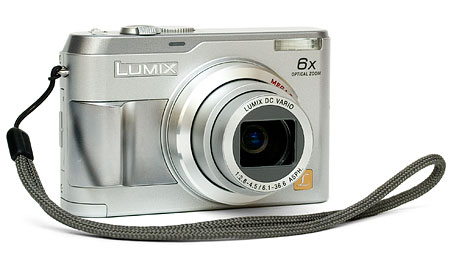
I think Panasonic's Lumix DMC-LZ1 is great value for money. You get a very versatile and sharp 6x zoom lens and optical image stabilisation in an attractive and affordable four megapixel package. Image quality and ease of use are booth very good, with only the lack of manual exposure controls being a slight sore point for more ambitious photographers.
Compared to the other cameras in this feature, the LZ1 starts up faster, is more responsive, with virtually no shutter lag. Its image stabilisation feature is a real boon in low light or when using the telephoto end of the zoom.
The DMC-LZ1 is a 'proper' digital still camera and it ought to trounce its company here in terms of image quality and that it certainly does.
Image quality
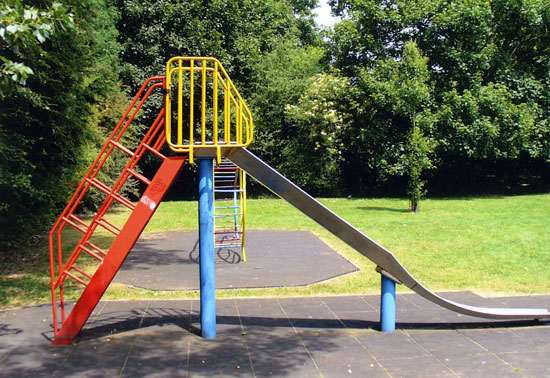
Now this is more like it! You can see in the shadows, the grass has texture and the highlights haven't been blown away. The colour is slightly on the side of yellow bias, which is typical of some Japanese cameras, but overall this print knocks the others into a very cocked hat.

Again, compared to the others, the print is crisp and punchy, but retains smooth and grain-free tones. The tee-shirt is slightly over-saturated but that's forgivable, as is the bleached cap on the right. I also took one with fill-in flash and if anything, that was even better.

Goodness! The sky has some blue in it at last and the scene is both sharp and smooth. There is no evidence of purple fringing. It's just… right.

There is probably as much detail in this selected enlargement as the whole print produced by some of the others looked at. This is the only camera that reveals the tops of the trees behind the building. There is no break up of the boundary between the tree foliage and the sky and there is no moiré effect on the roof.

Again, the DMC-LZ1 produced a much sharper print of the flowers than any of the others, but the colour is lacking a little of the purple I recall from the original scene.

Once again, the magnified corner sharpness is a revelation compared to the other cameras. Of the four, the LZ1 would be the only camera I’d have confidence in printing a selective enlargement.
Check the latest price or purchase options for the Panasonic Lumix DMC-LZ1 via

|

| 
|
| Click on the flag that best relates to your location |
| The EU flag links to Amazon Germany, currently the only European Amazon outlet that supplies electronic goods like cameras priced in Euros. |
| Each Amazon outlet can ship to most countries in the world. |
Conclusion
At no time did I expect the Panasonic Lumix DMC-LZ1 to be beaten by any of the hybrid cameras tested and that was certainly the case.
As I expected, neither the Nokia 7710 camera phone, nor the Sony PC105 camcorder produced 6x4 prints that I'd be really pleased about. Some people will be satisfied with the results, but they'd have to be very forgiving.
Even at the knock down price that you can buy a cheap digital camera like the Mustek D35 for, it is clear that it doesn't offer much of a quality advantage over the hybrids. If you have a decent one megapixel camera phone, like one of the Nokias, you will get comparable quality to the D35 for prints up to 6x4 inches. This would seem to confirm that the very cheap end of the dedicated digital camera market may be number its days.
The Sony PC105's results were a little disappointing, though the camera in question isn't as new as the others tested. Several camcorder models now offer two and three megapixel stills, while Sanyo has already been selling an innovative hybrid digital still and movie camera range.
I'll be testing Nokia's new range-topping N90 camera phone very shortly and this sports a new two megapixel camera module, with no less than autofocus and a Carl-Zeiss lens. This should give some indication if camera phones are improving fast enough to worry the manufacturers of better quality budget market digital cameras.
Do you get good still results from you’re the camera in your PDA, phone or camcorder? [email protected] Get in touch to let us know!




